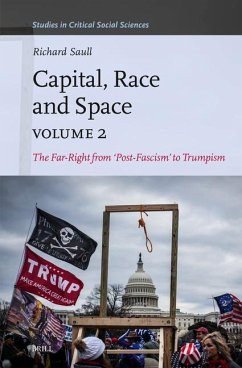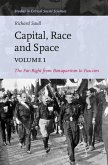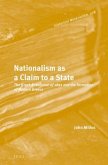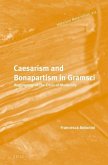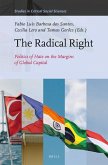- Gebundenes Buch
- Merkliste
- Auf die Merkliste
- Bewerten Bewerten
- Teilen
- Produkt teilen
- Produkterinnerung
- Produkterinnerung
In this second volume of Capital, Race and Space, Richard Saull offers an international historical sociology of the Western far-right from the end of World War II to its contemporary manifestations in Trumpism and Brexit through the prism of uneven and combined development.
Andere Kunden interessierten sich auch für
![Capital, Race and Space, Volume I Capital, Race and Space, Volume I]() Richard SaullCapital, Race and Space, Volume I185,99 €
Richard SaullCapital, Race and Space, Volume I185,99 €![Totalitarian Experience and Knowledge Production Totalitarian Experience and Knowledge Production]() Svetla KolevaTotalitarian Experience and Knowledge Production142,99 €
Svetla KolevaTotalitarian Experience and Knowledge Production142,99 €![Nationalism as a Claim to a State Nationalism as a Claim to a State]() John MiliosNationalism as a Claim to a State141,99 €
John MiliosNationalism as a Claim to a State141,99 €![Caesarism and Bonapartism in Gramsci Caesarism and Bonapartism in Gramsci]() Francesca AntoniniCaesarism and Bonapartism in Gramsci167,99 €
Francesca AntoniniCaesarism and Bonapartism in Gramsci167,99 €![White Christian Nationalism in the United States White Christian Nationalism in the United States]() Angelyn Spaulding FlowersWhite Christian Nationalism in the United States99,99 €
Angelyn Spaulding FlowersWhite Christian Nationalism in the United States99,99 €![The Radical Right The Radical Right]() The Radical Right155,99 €
The Radical Right155,99 €![Of Fear and Strangers Of Fear and Strangers]() George MakariOf Fear and Strangers28,99 €
George MakariOf Fear and Strangers28,99 €-
-
-
In this second volume of Capital, Race and Space, Richard Saull offers an international historical sociology of the Western far-right from the end of World War II to its contemporary manifestations in Trumpism and Brexit through the prism of uneven and combined development.
Produktdetails
- Produktdetails
- Verlag: Brill
- Seitenzahl: 444
- Erscheinungstermin: 15. Juni 2023
- Englisch
- Abmessung: 235mm x 155mm
- ISBN-13: 9789004539501
- ISBN-10: 9004539506
- Artikelnr.: 66275860
- Herstellerkennzeichnung
- Libri GmbH
- Europaallee 1
- 36244 Bad Hersfeld
- gpsr@libri.de
- Verlag: Brill
- Seitenzahl: 444
- Erscheinungstermin: 15. Juni 2023
- Englisch
- Abmessung: 235mm x 155mm
- ISBN-13: 9789004539501
- ISBN-10: 9004539506
- Artikelnr.: 66275860
- Herstellerkennzeichnung
- Libri GmbH
- Europaallee 1
- 36244 Bad Hersfeld
- gpsr@libri.de
Prologue
Acknowledgements
1 Fascist Legacies, the Far-Right and the Making of the Cold War Liberal
Order
1 The Theoretical Framing of the Cold War Western Liberal Order
1.1 Hegemony and the Far-Right in the Making of Liberal Order
2 The Cold War Liberal Order and the Far-Right after 1945
2.1 Fascist Legacies in the Post-war European Liberal State
2.2 Far-Right Movements and Parties in the Liberal Constitutional Order
2.3 Far-Right Violence, Para-Politics, and the Post-war Liberal State
2.4 Racialized Anti-communism and Political Economy in the US Cold War
Liberal Order
2.5 Racialized Anti-communism, Para-Politics, and the Liberal Historical
Bloc
2.6 Racialized Capitalism and the Political Economy of the New Deal
3 Conclusions
2 Neoliberal Globalization and the Rise of the ‘New’ Far-Right
1 Racial Imaginaries, the Far-Right and the Origins of Neoliberalism
1.1 Neoliberal Thinking
1.2 Neoliberal Politics
2 Neoliberal Globalization and the New International Political Economy of
the Far-Right
2.1 The Geography of Neoliberal Capitalist Accumulation
2.2 Neoliberal Financialization
2.3 Neoliberal Globalization and the Class Politics of ‘National Labour’
2.4 The Neoliberal International Institutional Order
2.5 The Post-cold War Geopolitical Landscape
3 The Politics of the Neoliberal Far-Right
3.1 Social Bases of Political Support
3.2 Racialized Social Conservatism
3.3 Welfare Nativism and Racialized Social Protectionism
3.4 Political Economy and the Nature and Limits of the Far-Right’s
‘Anti-capitalism’
3.5 The Framing of the International in the Neoliberal Far-Right
3.6 Post-fascism and Commitment to Liberal Democracy
4 Conclusions
3 Crisis Neoliberalism and the Far-Right
1 The Neoliberal Crisis and Its Consequences
2 Crisis Neoliberalism and the Onward March of the Far-Right
2.1 Trump and the American Far-Right
2.2 Trumpism and the Post-2007–8 Political Economy of the United States
2.3 The Post-crisis Far-Right
2.4 Sources and Spaces of Trumpism
2.5 The Trump Presidency
2.6 Britain: Brexit and Crisis Neoliberalism
2.7 Britain’s Post-crisis Political Economy
2.8 The Brexit Far-Right
2.9 Sources and Spaces of Brexit
2.10 Post-referendum Politics and Political Economy
2.11 Europe: the Contradictions of the EU’s Neoliberal Order and the
Refugee Crisis
2.12 Europe’s Post-crisis Political Economy and the Fault-Lines of the
Sovereign Debt Crisis
2.13 The Advances – and Limits – of the Post-crisis Far-Right
2.14 Germany
2.15 France
2.16 Italy
2.17 Greece
3 Conclusions
4 Conclusions
References
Index
Acknowledgements
1 Fascist Legacies, the Far-Right and the Making of the Cold War Liberal
Order
1 The Theoretical Framing of the Cold War Western Liberal Order
1.1 Hegemony and the Far-Right in the Making of Liberal Order
2 The Cold War Liberal Order and the Far-Right after 1945
2.1 Fascist Legacies in the Post-war European Liberal State
2.2 Far-Right Movements and Parties in the Liberal Constitutional Order
2.3 Far-Right Violence, Para-Politics, and the Post-war Liberal State
2.4 Racialized Anti-communism and Political Economy in the US Cold War
Liberal Order
2.5 Racialized Anti-communism, Para-Politics, and the Liberal Historical
Bloc
2.6 Racialized Capitalism and the Political Economy of the New Deal
3 Conclusions
2 Neoliberal Globalization and the Rise of the ‘New’ Far-Right
1 Racial Imaginaries, the Far-Right and the Origins of Neoliberalism
1.1 Neoliberal Thinking
1.2 Neoliberal Politics
2 Neoliberal Globalization and the New International Political Economy of
the Far-Right
2.1 The Geography of Neoliberal Capitalist Accumulation
2.2 Neoliberal Financialization
2.3 Neoliberal Globalization and the Class Politics of ‘National Labour’
2.4 The Neoliberal International Institutional Order
2.5 The Post-cold War Geopolitical Landscape
3 The Politics of the Neoliberal Far-Right
3.1 Social Bases of Political Support
3.2 Racialized Social Conservatism
3.3 Welfare Nativism and Racialized Social Protectionism
3.4 Political Economy and the Nature and Limits of the Far-Right’s
‘Anti-capitalism’
3.5 The Framing of the International in the Neoliberal Far-Right
3.6 Post-fascism and Commitment to Liberal Democracy
4 Conclusions
3 Crisis Neoliberalism and the Far-Right
1 The Neoliberal Crisis and Its Consequences
2 Crisis Neoliberalism and the Onward March of the Far-Right
2.1 Trump and the American Far-Right
2.2 Trumpism and the Post-2007–8 Political Economy of the United States
2.3 The Post-crisis Far-Right
2.4 Sources and Spaces of Trumpism
2.5 The Trump Presidency
2.6 Britain: Brexit and Crisis Neoliberalism
2.7 Britain’s Post-crisis Political Economy
2.8 The Brexit Far-Right
2.9 Sources and Spaces of Brexit
2.10 Post-referendum Politics and Political Economy
2.11 Europe: the Contradictions of the EU’s Neoliberal Order and the
Refugee Crisis
2.12 Europe’s Post-crisis Political Economy and the Fault-Lines of the
Sovereign Debt Crisis
2.13 The Advances – and Limits – of the Post-crisis Far-Right
2.14 Germany
2.15 France
2.16 Italy
2.17 Greece
3 Conclusions
4 Conclusions
References
Index
Prologue
Acknowledgements
1 Fascist Legacies, the Far-Right and the Making of the Cold War Liberal
Order
1 The Theoretical Framing of the Cold War Western Liberal Order
1.1 Hegemony and the Far-Right in the Making of Liberal Order
2 The Cold War Liberal Order and the Far-Right after 1945
2.1 Fascist Legacies in the Post-war European Liberal State
2.2 Far-Right Movements and Parties in the Liberal Constitutional Order
2.3 Far-Right Violence, Para-Politics, and the Post-war Liberal State
2.4 Racialized Anti-communism and Political Economy in the US Cold War
Liberal Order
2.5 Racialized Anti-communism, Para-Politics, and the Liberal Historical
Bloc
2.6 Racialized Capitalism and the Political Economy of the New Deal
3 Conclusions
2 Neoliberal Globalization and the Rise of the ‘New’ Far-Right
1 Racial Imaginaries, the Far-Right and the Origins of Neoliberalism
1.1 Neoliberal Thinking
1.2 Neoliberal Politics
2 Neoliberal Globalization and the New International Political Economy of
the Far-Right
2.1 The Geography of Neoliberal Capitalist Accumulation
2.2 Neoliberal Financialization
2.3 Neoliberal Globalization and the Class Politics of ‘National Labour’
2.4 The Neoliberal International Institutional Order
2.5 The Post-cold War Geopolitical Landscape
3 The Politics of the Neoliberal Far-Right
3.1 Social Bases of Political Support
3.2 Racialized Social Conservatism
3.3 Welfare Nativism and Racialized Social Protectionism
3.4 Political Economy and the Nature and Limits of the Far-Right’s
‘Anti-capitalism’
3.5 The Framing of the International in the Neoliberal Far-Right
3.6 Post-fascism and Commitment to Liberal Democracy
4 Conclusions
3 Crisis Neoliberalism and the Far-Right
1 The Neoliberal Crisis and Its Consequences
2 Crisis Neoliberalism and the Onward March of the Far-Right
2.1 Trump and the American Far-Right
2.2 Trumpism and the Post-2007–8 Political Economy of the United States
2.3 The Post-crisis Far-Right
2.4 Sources and Spaces of Trumpism
2.5 The Trump Presidency
2.6 Britain: Brexit and Crisis Neoliberalism
2.7 Britain’s Post-crisis Political Economy
2.8 The Brexit Far-Right
2.9 Sources and Spaces of Brexit
2.10 Post-referendum Politics and Political Economy
2.11 Europe: the Contradictions of the EU’s Neoliberal Order and the
Refugee Crisis
2.12 Europe’s Post-crisis Political Economy and the Fault-Lines of the
Sovereign Debt Crisis
2.13 The Advances – and Limits – of the Post-crisis Far-Right
2.14 Germany
2.15 France
2.16 Italy
2.17 Greece
3 Conclusions
4 Conclusions
References
Index
Acknowledgements
1 Fascist Legacies, the Far-Right and the Making of the Cold War Liberal
Order
1 The Theoretical Framing of the Cold War Western Liberal Order
1.1 Hegemony and the Far-Right in the Making of Liberal Order
2 The Cold War Liberal Order and the Far-Right after 1945
2.1 Fascist Legacies in the Post-war European Liberal State
2.2 Far-Right Movements and Parties in the Liberal Constitutional Order
2.3 Far-Right Violence, Para-Politics, and the Post-war Liberal State
2.4 Racialized Anti-communism and Political Economy in the US Cold War
Liberal Order
2.5 Racialized Anti-communism, Para-Politics, and the Liberal Historical
Bloc
2.6 Racialized Capitalism and the Political Economy of the New Deal
3 Conclusions
2 Neoliberal Globalization and the Rise of the ‘New’ Far-Right
1 Racial Imaginaries, the Far-Right and the Origins of Neoliberalism
1.1 Neoliberal Thinking
1.2 Neoliberal Politics
2 Neoliberal Globalization and the New International Political Economy of
the Far-Right
2.1 The Geography of Neoliberal Capitalist Accumulation
2.2 Neoliberal Financialization
2.3 Neoliberal Globalization and the Class Politics of ‘National Labour’
2.4 The Neoliberal International Institutional Order
2.5 The Post-cold War Geopolitical Landscape
3 The Politics of the Neoliberal Far-Right
3.1 Social Bases of Political Support
3.2 Racialized Social Conservatism
3.3 Welfare Nativism and Racialized Social Protectionism
3.4 Political Economy and the Nature and Limits of the Far-Right’s
‘Anti-capitalism’
3.5 The Framing of the International in the Neoliberal Far-Right
3.6 Post-fascism and Commitment to Liberal Democracy
4 Conclusions
3 Crisis Neoliberalism and the Far-Right
1 The Neoliberal Crisis and Its Consequences
2 Crisis Neoliberalism and the Onward March of the Far-Right
2.1 Trump and the American Far-Right
2.2 Trumpism and the Post-2007–8 Political Economy of the United States
2.3 The Post-crisis Far-Right
2.4 Sources and Spaces of Trumpism
2.5 The Trump Presidency
2.6 Britain: Brexit and Crisis Neoliberalism
2.7 Britain’s Post-crisis Political Economy
2.8 The Brexit Far-Right
2.9 Sources and Spaces of Brexit
2.10 Post-referendum Politics and Political Economy
2.11 Europe: the Contradictions of the EU’s Neoliberal Order and the
Refugee Crisis
2.12 Europe’s Post-crisis Political Economy and the Fault-Lines of the
Sovereign Debt Crisis
2.13 The Advances – and Limits – of the Post-crisis Far-Right
2.14 Germany
2.15 France
2.16 Italy
2.17 Greece
3 Conclusions
4 Conclusions
References
Index

